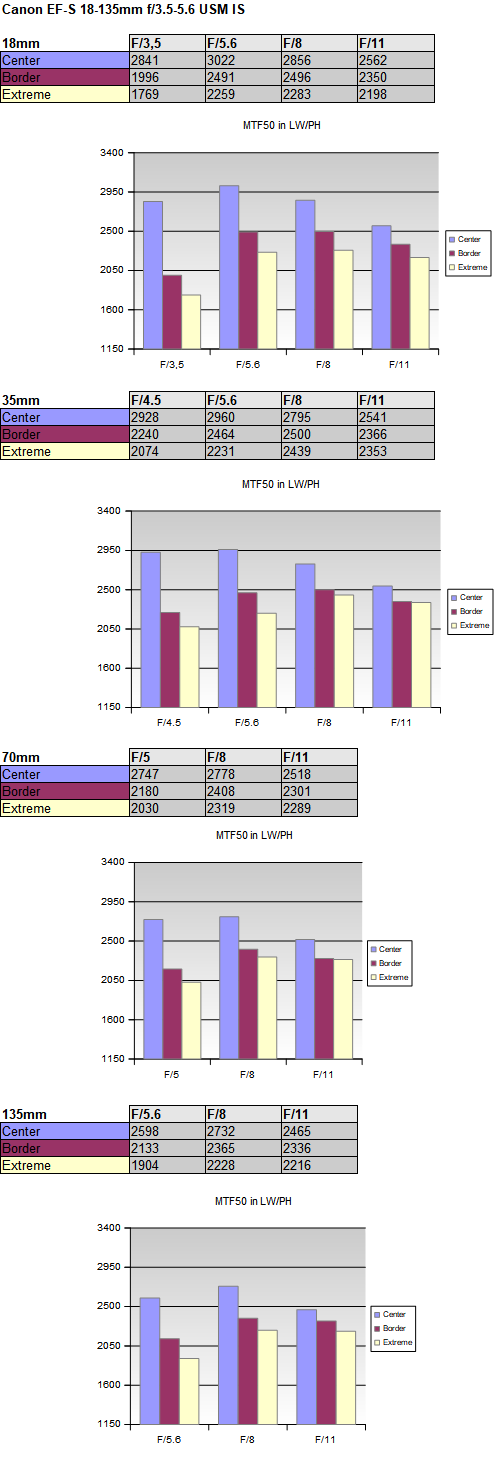|
Canon EF-S 18-135mm f/3.5-5.6 USM IS - Lab Review / Test - Analysis |
|
Lens Reviews -
Canon EOS (APS-C)
|
|
Page 2 of 2

Distortion
Typical for many "super" zoom lenses the Canon exhibits an heavy amount of barrel distortion at 18mm (~4.2%). The issue is gone at 35mm but beyond pincushion distortions are increasing up to a maximum of 1.2% at 135mm.
Vignetting
The vignetting characteristic of the Canon EF-S 18-135mm f/3.5-5.6 USM IS is about average for a lens in this class. Thus you have to live with rather heavy vignetting at wide-open aperture at 18mm and noticeable vignetting at 135mm @ f/5.6. However, stopping down by one f-stop solves most of the issue already.
It's interesting to note that the vignetting is slightly lower on images taken with the Canon EOS 7D II compared to the old EOS 50D. Most likely this relates a different tonal graduation of the JPEG engine in these cameras.

MTF (resolution)
The resolution figures are decent albeit fairly unexciting. Some of this may relate to the fact that the tested sample wasn't overly well centered (tilted focus plane) thus a "golden" sample should be better than that (although the higher resolution of the EOS 7D II has certainly an effect as well). The center quality is very good to excellent at 18mm till about f/8. As usual diffraction is a limiting factor from f/11 onward. The outer image regions shows some softness at f/3.5 but recovers nicely at f/5.6. The borders make it across the very good mark (just) whereas the corners are at least good. This characteristic remains intact at 35mm. From here on the quality decreases gradually towards 135mm. However, the center quality remains very good at 135mm followed by good borders. The corners are slightly soft at f/5.6 but improve the decent levels when stopping down.
Please note that the MTF results are not directly comparable across the different systems!
Below is a simplified summary of the formal findings. The chart shows line widths per picture height (LW/PH) which can be taken as a measure for sharpness.
If you want to know more about the MTF50 figures you may check out the corresponding Imatest Explanations

Chromatic Aberrations (CAs)
Lateral CAs (color shadows at harsh contrast transitions) can be visible at in the low to mid section of the zoom range. However, a peak CA width of 1.7px at 18mm (borders) isn't excessive. The CAs are very moderate at 70mm and increase just slightly towards 135mm again.

Verdict
This time weren't quite as impressed with Canon EF-S 18-135mm f/3.5-5.6 USM IS compared to its predecessor. The mentioned centering defect of the tested sample was probably a bit of a spoiler this time. The resolution is pretty good when stopping down a little although we didn't find any greatness either. The subjective quality perception is somewhat affected by visible lateral CAs in the lower zoom range. Some vignetting is obvious at 18mm at full open aperture albeit well controlled at other settings. Image distortions are high at 18mm as well but this is the price to pay for a long range standard zoom lens.
The build quality has been lifted to the standards of Canon's mid-grade lenses. Another improvement relates to the autofocus system. We didn't really have any issues with the old STM motor but Canon's new Nano USM is faster and remains as silent. If you are into videos, the optional motorized zoom adapter (200 US$) may come handy. The optical image stabilizer remains highly useful given the rather slow speed and fairly long tele setting of the lens.
So is it worth to upgrade ? If you already own the Canon EF-S 18-135mm f/3.5-5.6 STM IS, it's probably not worth it. They didn't lift the game in terms of optics and the mechanical improvements aren't drastic really. The STM lens is also still available and sells for almost half the price of the USM version thus till the existing stock has been depleted, it's hard to find a case for the more expensive lens actually. If you intend to purchase a camera-lens kit, it makes more sense because the overall package is somewhat cheaper than the sum of its individual components.
| Optical Quality: |
 to to  (somewhat affected by centering issue) (somewhat affected by centering issue) |
|
|
| Mechanical Quality: |  |
| Price/Performance: |  |
| | |
| | What does this mean ? |
|